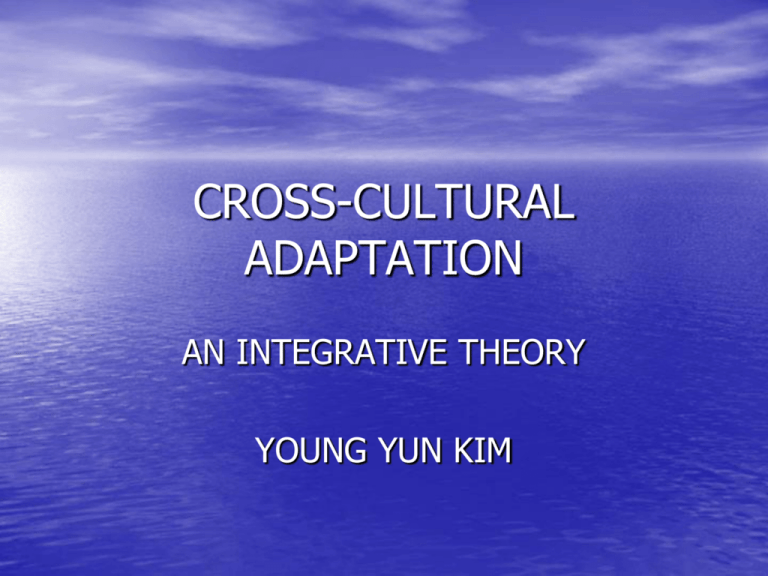cross-cultural adaptation
advertisement

CROSS-CULTURAL ADAPTATION AN INTEGRATIVE THEORY YOUNG YUN KIM INTRODUCTION • DESCRIBES THE PROCESS OF CROSS-CULTURAL ADAPTATION AS IT UNFOLDS OVER TIME • EXPLAINS THE STRUCTURE OF THIS PROCESS • IT IS BASED ON THREE ASSUMPTIONS (“OPENSYSTEMS”) 1. HUMANS HAVE AN INHERENT DRIVE TO ADAPT AND GROW 2. ADAPTATION TO ONE’S SOCIAL ENVIRONMENT OCCURS THROUGH COMMUNICATION 3. ADAPTATION IS A COMPLEX AND DYNAMIC PROCESS THE PROCESS OF CROSSCULTURAL ADAPTATION • CULTURE IS DEFINED AS: an imprinted pattern of knowledge, attitudes, values, perceptions and a set of behaviors that permeate all life activities Culture has a pervasive role in shaping individual behavior • ENCULTURATION: culture gives status and assigns the role of an individual in the life of the community (through socialization process) • ACCULTURATION: the process of learning and acquiring the elements of the host culture • UNLEARNING/DECULTURATION: losing or putting aside some of the old cultural habits / new responses are adopted in situations that previously would have evoked old ones The Stress-Adaptation-Growth Dynamic • STRESS: the generic response that occurs whenever the capabilities of the individual are not adequate to the demands of the environment Personality disintegration, state of disequilibrium Activation of a defensive mechanism to minimize the effects of the disequilibrium Response behaviors: selective attention, denial, selfdeception, avoidance, withdrawal, or, hostility, cynicism, compulsively altruistic behavior The Stress-Adaptation-Growth Dynamic • Adaptation: stress is temporary; it leads to adaptation because strangers strive to meet and manage the challenge by acting on and responding to the host environment • Growth: the stress-adaptation experiences bring about change and growth internal transformation creative responses to new circumstances a crisis once managed by the strangers presents an opportunity for a strengthening of their coping abilities The Stress-Adaptation-Growth Dynamic Overtime the stress-adaptation-growth dynamic plays out NOT in a smooth linear progression, but in a cyclic and continual draw-back-to-leap pattern Dialectic relationship between push and pull, or engagement and disengagement in the psychological movements of strangers Even those who interact with the natives with the intention of confining themselves to only superficial relationships are likely to become – given sufficient time – at least adapted to the host culture “in spite of themselves” Intercultural Transformation OUTCOMES OF THE ADAPTATION PROCESS 1. INCREASED FUNCTIONAL FITNESS: synchrony between strangers’ internal responses and the external demands in the host environment 2. PSYCHOLOGICAL HEALTH: ability to communicate and the accompanying functional fitness in the host society / psychological well-being 3. INTERCULTURAL IDENTITY: the original cultural identity begins to lose its distinctiveness and rigidity while an expanded and more flexible definition of self emerges THE STRUCTURE OF CROSSCULTURAL ADAPTATION • PERSONAL COMMUNICATION HOST COMMUNICATION COMPETENCE • SOCIAL COMMUNICATION 1. HOST INTERPERSONAL COMMUNICATION 2. HOST MASS COMMUNICATION 3. ETHNIC INTERPERSONAL AND MASS COMMUNICATION SYSTEMS THE STRUCTURE OF CROSSCULTURAL ADAPTATION • ENVIRONMENT 1. HOST RECEPTIVITY 2. HOST CONFORMITY PRESSURE 3. STRENGTH OF THE STRANGER’S ETHNIC GROUP • PREDISPOSITION 1. PREPAREDNESS 2. ETHNICITY 3. PERSONALITY TRAITS a. Openness b. Strength CONCLUSION • This theory portrays cross-cultural adaptation as a collaborative effort in which a stranger and a receiving environment are engaged in a joint venture • Cross-cultural adaptation is ultimately the gift of the individuals • Cross-cultural adaptation is not an extraordinary phenomenon that only exceptional individuals can achieve. Rather, it is simply an incident of the normal human mutability manifesting itself to the work of ordinary people “stretching” themselves out of the old and familiar





